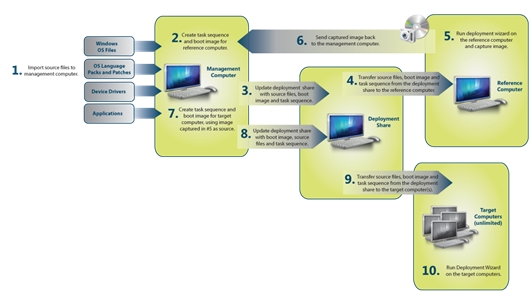Deploying Windows Server VMs with Microsoft Deployment Toolkit 2013 - Intro
Usually you can install virtual servers on four different ways:
- Installation from scratch
- image-based installations (e.g. Clonezilla)
- VMware templates and template customization specifications
- automated deployment
Except VMware templates you can use every technique to deploy physical and virtual servers. I would like to show you how you can install windows-based VMs with Microsofts Deployment Toolkit 2013 (MDT 2013). There are three articles in this series. The first article describes what you need for MDT 2013 and how you install WDS. The second article will show you how to configure MDT 2013, import the necessary drivers and OS images. The third article describes how to deploy a Windows 2008 R2 server with VMware Tools.
Articles
- Deploying Windows Server VMs with Microsoft Deployment Toolkit 2013 - Part I
- Deploying Windows Server VMs with Microsoft Deployment Toolkit 2013 - Part II
- Deploying Windows Server VMs with Microsoft Deployment Toolkit 2013 - Part III
What is Microsoft Deployment Toolkit 2013?
MDT 2013 allows you to automate the deployment of Windows OS and applications to clients and servers. MDT 2013 supports deployment of Windows 7, Windows 8, Windows 8.1, Windows Server 2008 R2, Windows Server 2012, and Windows Server 2012 R2. MDT 2013 uses image files that contains everything you need to install a Windows OS on a target computer, e.g. unattended setup files and drivers. MDT creates custom Windows Preinstallation Environment (Windows PE) images that are used to install the image onto the target computer. The Windows PE image can be booted using USB, CD/ DVD or Windows Deployment Services (WDS). You can run MDT 2013 standalone or with System Center Configuration Manager (SCCM). If using MDT 2013 as a standalone product, you can only do Lite Touch Installations (LTI). For Zero Touch Installations (ZTI) or User-Driven Installations (UDI) you need Microsoft System Center 2012 R2. Due this fact I will focus on LTI in this series.

Patrick Terlisten/ vcloudnine.de/ Creative Commons CC0
This figure was taken from the MDT 2013 documentation, which is available on microsoft.com. It shows the deployment process. I strongly recommend to read the documentation! You will quickly achieve results with MDT 2013, but it’s a very powerful solution. You will notice a steep learning curve. And if this curve isn’t steep enough, you can try SCCM. ;)
We will start with the basic installation. I will not show the installation of Active Directory or DHCP. We will beginn straigt with the installation of WDS, MDT 2013, and ADK for Windows 8.1.
Deploying Windows Server VMs with Microsoft Deployment Toolkit 2013 - Part I
